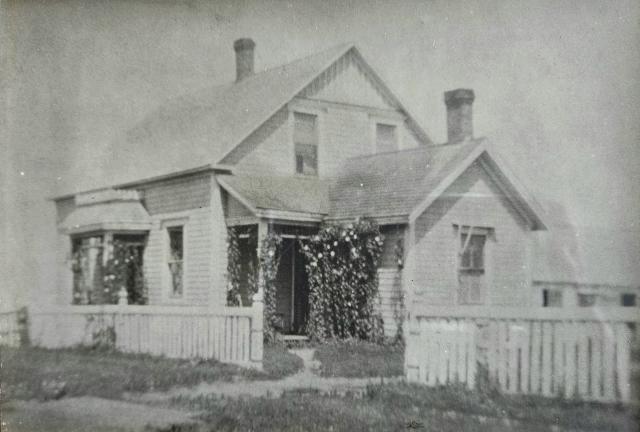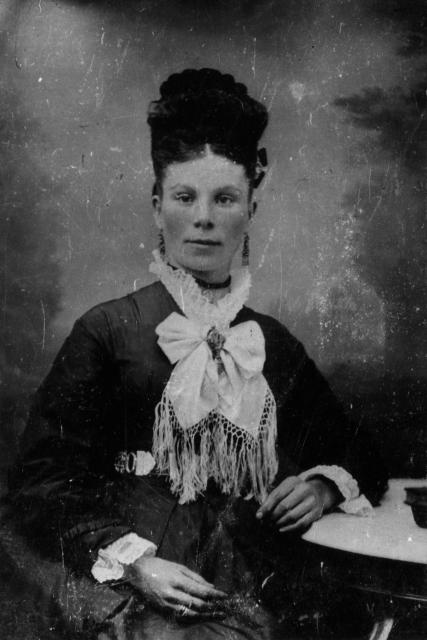While most readers envision L.M. Montgomery as a superstar novelist, her birth—and her mother—are less frequently considered. Baby Maud formed a loving bond in Clara Montgomery’s arms before she became a world-renowned author, making this a special Mother’s Day for Clara as well. Drawing from Maud’s journals, and weather and photographic records, this letter to Montgomery imagines her first two years of life with Clara in their New London birth house.

Dear Maud,
I work in your mother and father’s newlywed abode—now known as the Lucy Maud Montgomery Birthplace—throughout the seasons, when spring’s chainmail rain slides down glass panes, bonny red geraniums stretch and bloom in summery window boxes, and autumn’s leaves prance past on strong sea winds. As an interpreter, I help patrons understand what it was like when you lived in this community, in this style of house. And in doing so, I think about your life every day, despite the fact that you’ve been gone eighty-three years—much longer than I have been a fan, or have had the pleasure of being a docent at the New London cottage in which you were born.
Before you were L.M. Montgomery, the proud Prince Edward Islander and famous author of hundreds of short stories, poems, essays, and novels translated around the globe, you began life as many of us did, with humble beginnings: in a small rural community, within a modest house, to parents newly married and struggling with life’s challenges. Your birthplace is perched on the hilltop with a view down to New London harbour, a busy place when you were a babe, where a new bridge spanned the Southwest River and wagons and boats brought farm produce and fresh-caught seafood to local residents. This hamlet was previously known as Clifton, and your father Hugh Montgomery co-ran Clifton House, a general store right beside where you lived. Hugh married your mother, Clara, on 4 March 1874 at her Macneill parents’ house in Cavendish, when she was twenty-one and he thirty-three. He brought his bride here to live, in a modest three-up, three-down wooden cottage thought to be provided by your paternal grandfather, Senator Donald Montgomery of Park Corner.
You came along on 30 November 1874 within their first year of marriage and were named after your maternal grandmother, Lucy, and Queen Victoria’s granddaughter, Maud, who was born five years before you.
Quite frequently, patrons on spiritual Montgomery pilgrimages to your birthplace ask, “Do you ever see her ghost?” Occasionally, I wonder if the knocks and bumps upstairs are you. I don’t really imagine so, since you passed in Toronto and were laid to rest in Cavendish cemetery. Not even your mother died here. You only lived here as a baby, so it’s not likely that the creaks of the cottage are from your restless spirit. Perhaps it’s Clara’s labour pain I hear echoed in the moans of the house, disguised as the soughing of the wind over the eaves.
Your grandmother Lucy would have made a hurried trip to the house to be with her daughter throughout her first labour. Most people don’t think of you as a babe, but I do. Wee Maudie, nestled in your mother’s arms shortly after you were brought into the world, with a midwife in attendance, I’m told. Gazing up at Clara’s face, squinting your blue infant eyes, imprinting her features. Breathing in her scent. Tasting her milk. Despite it being a fliuch day, as your Gaelic husband Ewan may later have said, with lashings of rain and temperatures below 0˚C day and night (Daily Data), you were cozy. The cast-iron stove was stoked with wood, heavy kettles of water were boiled, and fresh linens and gowns were warmed on a rack to cocoon your two chilled bodies, cleansed after the ordeal.
It seems as if much of Clara’s time here with you was alone, with Hugh away at work or on business, and undoubtedly you were able to forge an exceptional early mother-daughter bond. As weeks went by, Clara experienced your growing phases: moving from Mother’s side in bed to cooing in your cradle, rocked one-handed as she sipped a welcome cup of soup. Your gurgling laugh when she settled you in a blanketed drawer as an improvised bed in the kitchen while she set bread. I bet Clara would have danced with you in her arms around the table, too, as most of us do with our babes.
And then, rolling over. At about eight months, you crawled the wide painted floorboards. Pulled yourself up on the settee into your first stand a month or two later, wobbly legged, before plunking down on your cotton-diapered bottom. Your initial steps taken somewhere close to your first birthday: now Clara was even busier, shooing you away from the hot stove when she made dinner, tying the cupboard doors closed, watching you didn’t creep up the steep staircase and fall back down again.
And then you began single sounds, in particular the simple word that thrilled Clara’s heart: Mama.
Yours was a warm, soft, loving world, as identified by a friend who knew your mother as “a beautiful, spiritual, poetical girl full of fine emotions and noble impulses” (CJ 2 [2 Jan. 1905]: 117). One of the Park Corner Montgomery women told you she recalled Clara exclaiming with delight when she dropped in unexpectedly: “Oh, I am so glad to see you … little Lucy Maud is so sweet and lovely to-day and Hugh John is away and I’ve no one to help me enjoy her!” (CJ 4 [25 June 1918]: 26). These were sweet stories of your “girlish mother—only 21—exulting in the charm of her baby,” just as you did with your sons Chester and Stuart (CJ 4 [25 June 1918]: 27).
It’s a shame that your mother didn’t get to a photographer’s studio with you for a portrait. I know it would have been a treasured item in your collection of memories, much like your early portrait with your son, Chester. In fact, that would be the most important thing to have in the Lucy Maud Montgomery Birthplace—a photo of Clara, beaming, with her beloved little Maudie on her lap.
I have no doubt that Clara was delighted with her firstborn—her only baby. It saddens me to think how bitter and angry she must have felt when she knew she was sick, because the prognosis of her disease was never good. Clara died before you were two years old, her life ruined by consumption, or tuberculosis as we think of it now. An illness that haunted you, Maud, after it stripped you of your mother too soon. The sorrow and waste of it frequently brought the dark enemy of tuberculosis into your writing: to Anne’s childhood friend Ruby Gillis in Anne of the Island, or in The Blue Castle when Valancy Stirling offered her humble services as a housekeeper for Cissy Gay, in “a house where a girl was dying of consumption” (Montgomery, BC 78). Like Clara, Cissy was a young mother, but she lost her baby before she died. Either way, the heartbreak of losing a child would be wrenching.
Despite being left with your mother’s parents on a prosperous North Shore farm—in a location that was rarely rivalled in your affections—it was difficult being motherless. There were scant memories of your mother offered from the family, and you didn’t recall your birthplace. You did, however, have a chance encounter with the wispy remnants of your mother’s handiwork in a sole pilgrimage to the old Cavendish house in 1927. A perennial that Clara had planted ran uninhibited from the ghosts of two small, square plots beneath the boughs of the apple trees in the back orchard. Overgrown with grasses, your mother’s gardens had set free the plumy, creamy-white flowers of an unnamed, low-growing perennial “that was always found in old-fashioned gardens,” though you had not found it since. The encounter of these flowers from the “dead and gone years” whispered peace to you. Clara’s enduring touch had burst free and wild, reminding you that some things continue to bloom years after you think they’ve gone, rather like your mother’s love (CJ 6 [26 July 1927]: 167–68).

You persevered with your life’s ambition: to write, to improve, and to publish. We know you wondered if your mother would have been proud of your success (CJ 4 [29 Dec. 1921]: 360). Perhaps you imagined Clara at your shoulder, reading drafts and chuckling while your pen flew across the paper. The short snippets of stories about her made you feel that if your mother had lived you would have been chums—“we would have understood each other” (CJ 4 [29 Dec. 1921]: 26), you believed. And then in 1908 that first novel arrived, Anne of Green Gables—dedicated to your lost mother and father—a runaway bestseller, now with well over 50,000,000 copies sold worldwide. How Clara would once again have danced with excitement!
You had the spirit of that wild November birth day in you, when you rose to superstardom as an author renowned in Canada and throughout the world. But I also feel that it was your mother’s love in those critical first months of your life that helped you become the woman you were.
As I wish you a happy 150th Birthday, Maud, may I also wish Clara, the woman who started it all, happy 150th Mother’s Day!
Bio: An independent researcher, Deborah Quaile is the docent for the Lucy Maud Montgomery Birthplace in New London, Prince Edward Island. She has written and presented about Montgomery, with particular emphasis on the author’s life in Norval, Ontario. Deb previously worked in a public library and also authored seven local history books.
Instagram: debquaile1
Banner Image: Clara Macneill Montgomery’s bedroom at the L.M. Montgomery Birthplace in New London. Photo by Deborah Quaile.
Works Cited.
Daily Data Report for November 1874, Charlottetown, Prince Edward Island. Government of Canada. 30 Jan. 2024. https://climate.weather.gc.ca/climate_data/daily_data_e.html?hlyRange=%7C&dlyRange=1872-04-01%7C1934-12-31&mlyRange=1872-01-01%7C1934-12-01&StationID=6525&Prov=PE&urlExtension=_e.html&searchType=stnProv&optLimit=specDate&StartYear=1840&EndYear=2018&selRowPerPage=25&Line=0&Month=11&Day=30&lstProvince=PE&timeframe=2&Year=1874
Montgomery, L.M. Anne of the Island. Ryerson Press, 1945.
---. The Blue Castle. Bantam Books, 1993.
---. The Complete Journals of L.M. Montgomery: The PEI Years, 1901–1911. [CJ 2]. Edited by Mary Henley Rubio and Elizabeth Hillman Waterston, Oxford UP, 2017.
---. L.M. Montgomery’s Complete Journals: The Ontario Years, 1918–1921. [CJ 4]. Edited by Jen Rubio, Rock’s Mills Press, 2017.
---. L.M. Montgomery’s Complete Journals: The Ontario Years, 1926–1929. [CJ 6]. Edited by Jen Rubio, Rock’s Mills Press, 2017.
